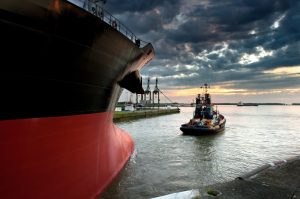 Tugs are designed with high propulsion power for pulling and pushing heavy floating objects at relatively low speed. They are equipped with high engine power and are highly manoeuvrable. The latest models with more than 60,00 BP are adapted to the new megaships era.
Tugs are designed with high propulsion power for pulling and pushing heavy floating objects at relatively low speed. They are equipped with high engine power and are highly manoeuvrable. The latest models with more than 60,00 BP are adapted to the new megaships era.
Tugs are primarily used to assist ocean-going ships in ports. However, many additional applications have been developed for coastal towages, for offshore support work or for worldwide towage services.
The Towage Industry can be divided into the following main sectors:
- Port Towage, large ships normally require tug assistance for manoeuvring to and from their berth. The need for tug assistance increases with the ship’s size, complexity of the waterways and docking facility as well as weather conditions. Tug assistance of a vessel consists of a number of tugs pushing and/or pulling for holding, slow movement and/or positioning of the floating object.
- Escorting, Tug escort services are implemented in several areas where ports and terminals have complex and/or narrow entrances as it increases the safety of an operation in case of a ship’s technical failure where the consequence of such failure may be environmentally dramatic.
- Coastal and Deepsea Towage, Tugs are often used for coastal towages of floating ships or equipment along European coastlines or even on a world-wide basis. In addition to the personnel employed in the towage industry, many jobs are required in support industries like yards, bunker-suppliers, service providers, etc.
- Ice Breaking, in northern areas, special icebreaking tugs are required for maintaining access to and from ports during cold winters.
- Safety Services, at all times, tugs have been crucial not only in avoiding accidents, but also in emergency situations rescuing the equipment, human life and protecting the environment. This service may include the use not only of the tug itself, but also important equipment onboard as oil spill control, salvage or wreck removal.
- Other Services, Tug assistance is often used for mooring ships, boarding pilots and many more situations.